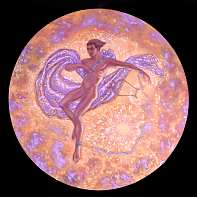Giovanni Truncellito
text by
CESARE NISSIRIO

What captures my interest about the art of Giovanni Truncellito is
his constant reference to the four fundamental elements of life. Air, water, earth and
fire, are the dominating characters of his works. Everything seems to work around them and
their esoteric, literate and musical significance which he seems to combine in his
artistic compositions proposing unequivocal signs and symbols. The movement, a type of
cosmic revolution, agitates the scene where his characters interact, as if in their own
private eden. Strangely enough the role leader in his paintings is not just man, emerging
from a classical world, from the myth of a lyrical vision in a musical and artistic
formation, but the "location" of the becoming, the space of the scenic action,
and the material and artistic components which they express, they evoke and they relate.
What principally takes the eye is the elliptic movement, the atmosphere, the air it
breathes: everything seems to exalt in a sort of emotive vortex, of exasperation, of
accentuated vibrancy which finds in the strong colour of the painting, its reason of
being.
His artistic space is a turmoil. Nothing which surrounds his heroes is static but rather
similar to a lava flow of shapes and colours which assume the form of a wavy river. It is
in this exiting context that the emotion pulsates, the legends and the stories inspired by
opera to which the artist-musician entrusts his artistic brushes. Strangely though, the
less his characters move, stronger is the evocative force of a distant past but which
still today influences the original classical culture of the artist of the Magna Grecia.
The plasticity and the aesthetical composure, the statue forms of the human components
seem to be in contrast to the imaginative, the oneiric, the surreal of the rest of the
surface of the painting which, due to its exuberance, causes one to be in some way
startled, perturbed. The colours are fiery, like a tempest sun, the reds, yellows, oranges
all disturb the blue of the waters or the sky-blue of the invented skies. The greens and
blues invade the tender tones of the unlikely, dreamy landscape. There is turbulence in
the air as in the heart of the heroes of the melodrama which Giovanni Truncellito
proposes. They sometimes appear unperturbed, but only apparently: Medea, Orfeo, Norma all
mythical heroes in the musical world so dear to Maria Callas, live a different life to
that expected. Faces adorned with parures of jewels the colour of the sea; sapphires,
amethysts, turquoises in their esoteric colours enhance the beauty of the heroines, whilst
agile male limbs composed from the sky, white clouds and floral compositions alternate
with the statute like nudity and elegance of the imposing male figures, sons of gods
dignified and aloof. Nothing is outrageous and yet everything is deranging due to the
force and sensuality that they transmit, that they irradiate.
Giovanni Truncellito does not easily forget the culture of his Mediterranean origins, his
relationship with Greek mythology, and never loses sight of the scenographic taste of his
formation as an architect which also owes a lot to ancient Greece, not just for the
presence of real or re-invented architectural elements in the paintings, but also for the
general scenographic composition of the works which is never left to chance but always
shows precise, rigorous research.
The structure of the painting is often elaborated according to imaginary architectural
schemes, which impose on the mental concept, the primigenial rather than the formal idea
of the painting. Everything evokes the Callas world where the artist tends to divest the
protagonists from their melodramatic robes which is how we normally imagine those in the
lyrical and operatic world. The earthly paradise where Giovanni Truncellito still lives,
the eden where he daily meets his heroes, today has a different atmosphere, new and
ancient at the same time, never banal or obvious due to the uncountable implications that
it is able to insinuate. In this air of "madness" which has in fact become one
of the subjects of his artistic inspiration among the works exhibited, one can see the
extraordinary entwining of music, art, architecture and unbridled fantasy of the artist.
It is immediately noticeable that his heroes have changed. I thank him for this with an
emotional heart.
Cesare Nissirio